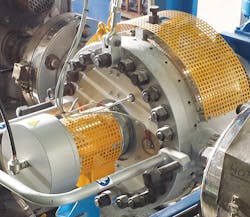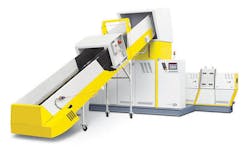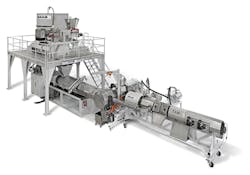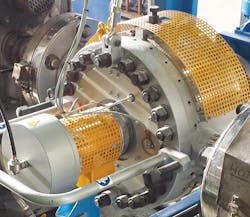NPE: Reclaim system suppliers show off latest, greatest
Reclaim system suppliers at NPE came to market their engineering services and hardware for a wide range of custom lines that included, as needed, washing, size-reduction, densifying, extrusion, filtration, pelletizing, and material handling. Needs vary widely, depending on the materials, type and amount of contamination, moisture load, required output, and other factors. Innovations can come in a single piece of equipment, or in the design of the entire line.
There is no bright white line dividing single-unit and systems suppliers. Sometimes systems firms supply a single machine and sometimes single-machine specialists integrate several pieces. This article focuses on designers and suppliers primarily of entire systems, and future coverage will be directed toward suppliers of discrete granulators, shredders, and related equipment.
ADG Solutions (ADGS), Fairfield, Conn., engineers and installs entire lines of reclaim equipment, or, as the need arises, a single piece of equipment. ADGS presented new self-cleaning screen changers, ram-stuffer technology and other plastics reclaim technology at NPE.
An APR 500 continuous self-cleaning screen changer with new control programming from Fimic Officine Meccaniche srl, and a 6-inch Davis-Standard LLC ram stuffer were displayed at the ADGS booth. Also featured were separation and washing systems from Tecnofer, shredders from Weima America and densification systems from Promeco SpA. ADGS announced the first installation of a Promeco system in North America.
The Fimic Model APR continuous, self-cleaning screen changers with new control programming are suited for highly contaminated reclaim extrusion streams. In operation, the melt-filtration unit is positioned at the extruder outlet so that it retains contaminants as small as 150 microns, about the size of fine sand from a beach. As contamination builds up on the upstream side of the screen, inlet pressure increases to set point (set on the pressure control), triggering a scraper that removes contamination from the face of the screen filter.
Sandy Guthrie, founder and president of ADGS, pointed out that most self-cleaning screen changers channel some polymer melt to purge the contaminants from the screen through a discharge valve. Over time this approach can divert significant amounts of valuable resin. The new Fimic units, however, store the contaminants from up to six scrapings, and discharge all the accumulated contamination at once. This system can cut the amount of resin wasted in the cleaning process by half or even two-thirds.
Other innovations include laser-cut screen plates that extend operating life. With a large open area, back pressure is minimized, even at fine filtration levels. A continuous–scraping mode is available to prevent pressure instability by immediately removing contaminants that can quickly blind the screen. The Fimic line of self-cleaning filters delivers the lowest cost of operation in the industry and is extremely rugged and durable, says Guthrie.
Ram stuffers, such as the Davis-Standard unit displayed in the ADGS booth, can be added to an extruder to handle a wide variety of feedstock sizes and types. The super-size feed throat maximizes in-feed for consistently high extruder output even when processing low-density scrap material, including fractional-gauge films. Feedstock size and shape have almost no effect on the throughput of the extruder.
Besides the ram-stuffer units, ADGS offers Davis-Standard wide-mouth extruders and cascade systems, with integrated system controls for lines processing up to 12,000 pounds per hour.
Gamma Meccanica North America, Greer, S.C., describes itself as promoting green equipment solutions for reprocessing low bulk density, heavily printed, and high residual moisture plastics using turnkey force-feed, cutter-compactor and conventional reclaim systems.
Heath Sellers of Gamma Meccanica told Plastics Machinery Magazine that the company uses a variety of controls depending on the client's preference.
For example, the company uses Siemens PLCs and human machine interface (HMI) standard in its controls and ABB motors and drives. But it will use Allen-Bradley or other main controls depending on the client's preference. Sellers described Gamma Meccanica as "selling the application, not just the machinery" and said the company works with Gala Industries Inc., Herbold Meckescheim USA, Nordson Xaloy Inc., Weima and others to provide the machinery for its Gamma Meccanica-designed and specified lines. Sellers identifies the company as a supplier of custom, heavily engineered lines and said it does projects ranging from $50,000 to several million dollars in price.
The Gamma Meccanica systems are designed to recycle materials in a wide variety of forms: film, bottles, containers, and others. The Gamma Meccanica lines use a variety of equipment configurations to address different needs. Compac systems consist of a cutter-compactor, extruder, filter and pelletizer. PMM covered that system in its April edition, page 33. Conventional systems use a grinder or granulator, force feeder, extruder, filter and pelletizer.
More solutions are available now for challenging materials that once were not considered for reprocessing. Gamma is active in that area. One solution is the GM Tandem line, which is used for recycling heavily printed, high-humidity (exceeding 15 percent) and highly contaminated materials.
The system is composed of Compac feeding technology and two extruders placed in tandem. The effectiveness of the line is attributable to a patented degassing system. The gases or vapors that are formed from the melted material mixed inside the primary extruder are eliminated by the extraction force created by the vacuum.
On the secondary extruder an additional degassing system can be installed to expel residual gases. Two screen changers can be connected: one after the primary extruder that expels the largest elements of contamination and the other after the secondary extruder that eliminates particles down to 50 to 100 micrometers.
Herbold, Slatersville, R.I., a supplier of both single units and complete systems, reported at NPE that it has redesigned its SMS Series granulators to cope with the most demanding heavy-duty size reduction applications in a single step. These machines are manufactured with rotor widths ranging from 23.5 to 78.75 inches with drive capacities between 60 and 420 horsepower. The knives are in segments, thus allowing rapid exchange of the cutting tools. The SMS units are equipped with a third bed knife called a deflection wedge. The deflection wedge can be removed to accommodate bulky items.
Herbold's complete wash lines for recycling plastics consist of de-balers, granulators, washers, shredders, separators, and dryers. Components of the systems are designed as modular building blocks so that a system can be extended or modified according the specific requirements at hand.
The de-baler breaks down pressed bales or briquettes of bottles and other postconsumer plastic waste into single items for sorting. Metal-detection and removal can be performed at this stage.
Wet granulators have water in their cutting chambers for the simultaneous washing and size reduction of feed material. A screen or dewatering screw separates the plastic fragments from much of the dirty wash water containing paper bottle labels and other coarse contamination. High-speed shredders (modified impact hammer mills) can be used with water and added to a wash line when more intensive washing and shredding is necessary. They remove glue, paints and labels.
Friction washers typically receive a slurry of plastic fragments and water from a wet grinder/granulator, but they are sometimes installed after separation tanks. Fed from the lower end of its inclined cylindrical trough, a friction washer makes use of a fast–running paddle screw to dewater and clean the fragments as they are transported to the outlet at the top of the trough.
Separation tanks separate floating materials from sinking materials. Fed by mixing fans (turbo washers) and operating under pressure, hydrocyclones, often used in recycling PET bottles, accomplish the same task more effectively, especially when used in combination with a separation tank.
Floating materials leave at the upper end of a hydrocyclone with most of the water while sinking materials are expelled from the lower end. This effect can be adjusted by changing the sizes of the outlet nozzles. Filters, pumps and piping can also be set up to recirculate wash water.
Mechanical dryers can centrifugally dry plastic fragments while spinning off some remaining contaminants, but they can also be used as intensive washers. The washing version uses a high-speed agitator and high volume of water to remove paper and other contaminants. Thermal dryers provide additional drying when necessary for difficult-to-dry materials such as stretch film and foam.
The HV Plascompactor simultaneously heats, dries, and compacts.
Vecoplan LLC, Archdale, N.C., introduced at NPE its HydroDyn plastics washing line to the North American market. Vecoplan says the line has been proven in European recycling plants. HydroDyn uses the dynamic properties of water spun in a cyclonic fashion to generate horizontal friction and clean plastic flake suspended in that water.
In addition to washing the plastic flakes, friction created by centrifugal force in the water also generates heat. Since it is a closed system, integrating its own water treatment, the reused water process establishes a hot wash system without additional power or gas usage. The overall system results in a reported 25 percent operating cost savings accounted for by reduced consumption of energy, water, and chemicals.
HydroDyn is a modular system pre-installed on platforms, which eliminates the need for onsite bases or other foundation work to support individual pieces of equipment. All components are pre-assembled with piping and electrical wiring included in the platform chassis, as is built-in drainage for spill water.
MAS America, Pineville, N.C., presented its alternative to wet cleaning, using a Double Rotor Disk, a patented technology that cleans films and fibers without using water. It combines a cleaning centrifuge and thermal dryer in one machine to perform a clean, dry process to deliver high-quality end-product. MAS considers this to be the pioneering alternative to wet systems in the recycling process.
The conical co-rotating twin-screw extruder from MAS is ideal for compounding and recycling in one step, which is called recompounding. The MAS patented filter technology provides continuous melt filtration to remove paper, aluminum, and wood.
The MAS drying and cleaning system consists of a single-shaft shredder, material storage facility, dry cleaning unit and conveyors. The material is temporarily stored in a silo. The plastic flakes are then metered into the extruder volumetrically by a screw feeder. Alternatively, the flakes can be fed gravimetrically with the option to compound additives to improve the quality of the plastic.
Downstream melt filtration removes the remaining impurities from the melt prior to entering the head of the pelletizer. The plastic pellets are then dewatered and run through a centrifugal dryer. Significant energy savings is achieved due to optional reuse of energy included in the pelletizing process water and by recovering the warm air from the dryer exhaust system.
Next Generation Recycling Machines Inc., (NGR), Norcross, Ga., introduced its P:REACT process equipment at NPE. P:REACT utilizes the inherent capability of PET to release condensate in the molten phase under vacuum, which leads to an increase in intrinsic viscosity. The vacuum effectively removes chemical contaminants from the material. As molten PET enters the vertical part of P:REACT, strands are formed to create a suitable surface-to-volume ratio. The material is then collected in a horizontal drum and slowly pushed forward. Condensate removal starts immediately as the strands are formed.
NGR business unit Collin Lab & Pilot Solutions introduced at NPE the T:FILTER for inline analysis of melt purity. Designed for plastic converters, compounders and recyclers, the T:FILTER takes melt from the main extruder and automatically tests the purity of the material. Information is displayed immediately to the operator, who does not have to wait for a separate lab-analysis. This helps keep high-quality resin away from lower-quality material.
BritAs Filtration Systems, now part of NGR, introduced the BritAS automatic band melt filter designed to handle high volumes of heavily contaminated melt streams, predominantly PE but also PP. The filtration system provides effective cleaning of plastic melts to a fineness of 70 micrometers. At each automatic screen change, the band completely renews the area of filtration.
NGR also presented the latest evolution of its shredder/feeder/extruder combination, S:GRAN 75 V HD, which now is equipped with a control unit that automatically adjusts the shredding pressure to reach optimal recycled pellet quality. It is designed to allow the input of thermoplastics scrap of virtually any shape and size.
The control takes into account process stability, energy efficiency and on-site material logistics. The control's touchscreen calls for maintenance when required. Together with incorporated maintenance videos and electronic manuals, the machine actively assists the operator, minimizing downtime. An optional web interface allows for remote monitoring of the recycling process by NGR engineers.
Merle R. Snyder, senior correspondent
Contact:
ADG Solutions, 203-255-9444, www.adgs.netNext Generation Recycling Machines Inc., 678-720-9861, www.ngr.atGamma Meccanica North America, 864-675-0775, www.irecyclingsolutions.comHerbold Meckescheim USA, 401-597-5500, www.herboldusa.comVecoplan LLC, 336-252-4066, www.vecoplanllc.comMAS America, 704-944-3232, www.mas-america.com



